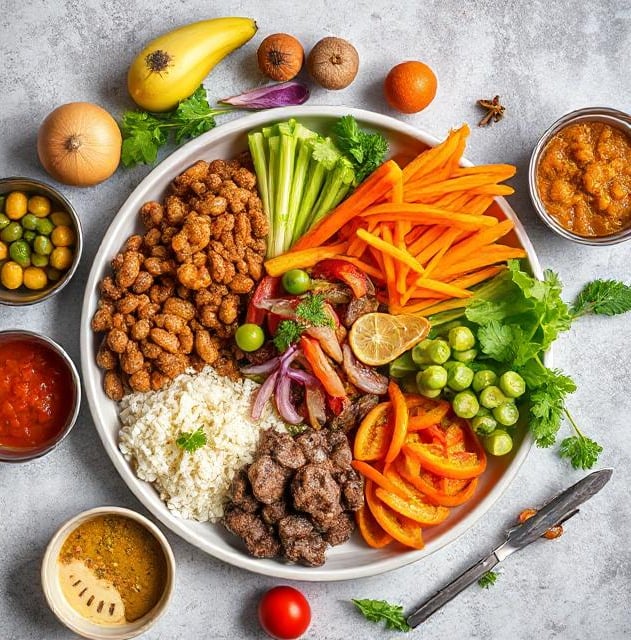Nutrition in our foods!
A Simple Guide to Understanding Carbs, Proteins & Nutrients in Indian Foods
7/30/20252 min read


“Eat healthy.”
“Have a balanced diet.”
“Cut down on carbs.”
You’ve probably heard all of this before—but what does it really mean?
The truth is, most people don’t need extreme diets. What we need is awareness: understanding what each meal is made of, how different food groups fuel the body, and how to balance them without overthinking.
In this blog, we break down what makes a nutritious meal, explore carbs, proteins, and micronutrients, and show you how to make sense of your plate—especially with common Indian foods.
🥗 What Is a Nutritious Meal?
A nutritious meal is one that provides:
Sustained energy (from healthy carbs)
Tissue repair & strength (from proteins)
Vitamins, minerals & fiber (from vegetables, fruits, and spices)
Good fats (from nuts, seeds, oils)
It’s not about cutting out a food group, but about balance and mindfulness. Every meal should ideally include:
A source of carbohydrate
A source of protein
A variety of micronutrient-rich foods
🍚 1. Carbohydrates – Your Energy Fuel
Carbs are often misunderstood. Yes, excessive refined carbs can cause weight gain and blood sugar issues—but carbs are essential, especially in a typical Indian lifestyle.
✅ Common Indian Carb Sources:
Rice (white or brown)
Roti/chapati (wheat, jowar, bajra)
Poha, upma, idli
Potatoes, sweet potatoes
Dals and legumes (also contain carbs + protein)
🔑 How Much Is Too Much?
If your plate is mostly rice or roti, and very little else—that’s when carbs are too much. Ideally, carbs should be about 1/3 of your plate, especially if you’re not very physically active.
Balance tip: Instead of removing carbs, add more veggies and protein to the meal.
🍳 2. Protein – The Building Block
Protein helps with muscle repair, hormonal balance, and immunity. Yet, many Indian diets are low in protein, especially vegetarian ones.
✅ Common Indian Protein Sources:
Dals and legumes (rajma, chole, moong)
Paneer, curd, milk
Eggs, chicken, fish
Soy, tofu, sprouts
Nuts and seeds (almonds, chia, flax)
🍽 What a High-Protein Indian Meal Might Look Like:
Moong dal + roti + sabzi + curd
Grilled paneer with sautéed veggies + jeera rice
Egg bhurji + grilled chicken
Chicken curry + stir-fried greens + brown rice
🥦 3. Nutrient-Rich Foods – The Missing Piece
These include vitamins, minerals, fiber, and antioxidants that support digestion, brain function, skin health, and disease prevention.
They’re often forgotten or minimized in typical meals.
✅ Common Nutrient-Dense Indian Foods:
All vegetables, especially leafy greens (spinach, methi, moringa)
Fruits (banana, papaya, berries, citrus)
Spices like turmeric, ginger, cumin, coriander
Fermented foods like curd, pickles (in moderation)
🥗 A High-Nutrient Indian Meal:
Mixed veg sabzi with haldi + methi roti + cucumber raita
Vegetable khichdi with ghee and pickle
Fruit bowl with chia seeds
Coconut chutney + steamed greens
🧠 Why Mindful Eating Matters
It’s not just about what you eat, but how you eat.
When you start observing your plate—asking, “Where’s the protein?” or “Is this mostly carbs?”—you build food awareness.
That’s what mindful eating means.
It helps you:
Make better food choices, without guilt
Avoid over-eating
Feel more satisfied after meals
Recognize when your body needs more or less of something
✅ Final Takeaway
You don’t need to follow extreme diets.
You just need to build awareness of what’s on your plate.
Carbs give energy.
Protein builds strength.
Nutrients support your body’s internal systems.
Every meal is an opportunity to nourish your body—not restrict it.
And with a little thought and balance, even simple Indian meals can be wonderfully nutritious.
Want help planning your meals or understanding what works for your lifestyle?
At Trainer Hub, we combine movement coaching with basic nutrition education—so your health journey is complete, personalized, and pressure-free.


